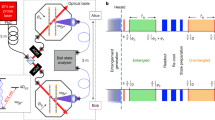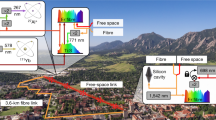Abstract
The development of precise atomic clocks plays an increasingly important role in modern society. Shared timing information constitutes a key resource for navigation with a direct correspondence between timing accuracy and precision in applications such as the Global Positioning System. By combining precision metrology and quantum networks, we propose a quantum, cooperative protocol for operating a network of geographically remote optical atomic clocks. Using nonlocal entangled states, we demonstrate an optimal utilization of global resources, and show that such a network can be operated near the fundamental precision limit set by quantum theory. Furthermore, the internal structure of the network, combined with quantum communication techniques, guarantees security both from internal and external threats. Realization of such a global quantum network of clocks may allow construction of a real-time single international time scale (world clock) with unprecedented stability and accuracy.
This is a preview of subscription content, access via your institution
Access options
Subscribe to this journal
Receive 12 print issues and online access
$209.00 per year
only $17.42 per issue
Buy this article
- Purchase on Springer Link
- Instant access to full article PDF
Prices may be subject to local taxes which are calculated during checkout


 using clock networks of different types and degrees of cooperation.
using clock networks of different types and degrees of cooperation.

Similar content being viewed by others
References
Bloom, B. et al. An optical lattice clock with accuracy and stability at the 10−18 level. Nature 506, 71–75 (2014).
Hinkley, N. et al. An atomic clock with 10−18 instability. Science 341, 1215–1218 (2013).
Nicholson, T. L. et al. Comparison of two independent Sr optical clocks with 1 × 10−17 stability at 103 s. Phys. Rev. Lett. 109, 230801 (2012).
Leroux, I. D., Schleier-Smith, M. H. & Vuletić, V. Implementation of cavity squeezing of a collective atomic spin. Phys. Rev. Lett. 104, 073602 (2010).
Buzek, V., Derka, R. & Massar, S. Optimal quantum clocks. Phys. Rev. Lett. 82, 2207–2210 (1999).
Ye, J. et al. Delivery of high-stability optical and microwave frequency standards over an optical fiber network. J. Opt. Soc. Am. B 20, 1459–1467 (2003).
Droste, S. et al. Optical-frequency transfer over a single-span 1840 km fiber link. Phys. Rev. Lett. 111, 110801 (2013).
Cirac, J., Zoller, P., Kimble, H. & Mabuchi, H. Quantum state transfer and entanglement distribution among distant nodes in a quantum network. Phys. Rev. Lett. 78, 3221–3224 (1997).
Kimble, H. J. The quantum internet. Nature 453, 1023–1030 (2008).
Perseguers, S., Lapeyre, G. J., Cavalcanti, D., Lewenstein, M. & Acín, A. Distribution of entanglement in large-scale quantum networks. Rep. Prog. Phys. 76, 096001 (2013).
Nielsen, M. A. & Chuang, I. L. Quantum Computation and Quantum Information (Cambridge Univ. Press, 2000).
Duan, L. M., Lukin, M. D., Cirac, J. I. & Zoller, P. Long-distance quantum communication with atomic ensembles and linear optics. Nature 414, 413–418 (2001).
Bollinger, J., Itano, W., Wineland, D. & Heinzen, D. Optimal frequency measurements with maximally correlated states. Phys. Rev. A 54, R4649–R4652 (1996).
Leibfried, D. et al. Toward Heisenberg-limited spectroscopy with multiparticle entangled states. Science 304, 1476–1478 (2004).
Wineland, D. et al. Experimental issues in coherent quantum-state manipulation of trapped atomic ions. J. Res. Natl Inst. Stand. Technol. 103, 259–328 (1998).
Kessler, E. M. et al. Heisenberg-limited atom clocks based on entangled qubits. Phys. Rev. Lett. 112, 190403 (2014).
Giedke, G., Taylor, J., D Alessandro, D., Lukin, M. & Imamolu, A. Quantum measurement of a mesoscopic spin ensemble. Phys. Rev. A 74, 032316 (2006).
Huelga, S. F. et al. Improvement of frequency standards with quantum entanglement. Phys. Rev. Lett. 79, 3865–3868 (1997).
Rosenband, T. & Leibrandt, D. R. Exponential scaling of clock stability with atom number. Preprint at http://arXiv.org/abs/1303.6357 (2013).
Borregaard, J. & Sørensen, A. S. Efficient atomic clocks operated with several atomic ensembles. Phys. Rev. Lett. 111, 090802 (2013).
Escher, B. M., de Matos Filho, R. L. & Davidovich, L. General framework for estimating the ultimate precision limit in noisy quantum-enhanced metrology. Nature Phys. 7, 406–411 (2011).
Borregaard, J. & Sørensen, A. S. Near-Heisenberg-limited atomic clocks in the presence of decoherence. Phys. Rev. Lett. 111, 090801 (2013).
Chou, C. W., Hume, D. B., Koelemeij, J. C. J., Wineland, D. J. & Rosenband, T. Frequency comparison of two high-accuracy Al+ optical clocks. Phys. Rev. Lett. 104, 070802 (2010).
Monz, T. et al. 14-qubit entanglement: Creation and coherence. Phys. Rev. Lett. 106, 130506 (2011).
Maunz, P. et al. Quantum interference of photon pairs from two remote trapped atomic ions. Nature Phys. 3, 538–541 (2007).
Schiller, S. et al. Einstein Gravity Explorer—A medium-class fundamental physics mission. Exp. Astron. 23, 573–610 (2008).
Sørensen, A. & Mølmer, K. Entanglement and quantum computation with ions in thermal motion. Phys. Rev. A 62, 022311 (2000).
Gisin, N., Ribordy, G., Tittel, W. & Zbinden, H. Quantum cryptography. Rev. Mod. Phys. 74, 145–195 (2002).
Olmschenk, S. et al. Quantum teleportation between distant matter qubits. Science 323, 486–489 (2009).
Chou, C-W. et al. Functional quantum nodes for entanglement distribution over scalable quantum networks. Science 316, 1316–1320 (2007).
Togan, E. et al. Quantum entanglement between an optical photon and a solid-state spin qubit. Nature 466, 730–734 (2010).
Bernien, H. et al. Heralded entanglement between solid-state qubits separated by three metres. Nature 497, 86–90 (2013).
Ristè, D. et al. Deterministic entanglement of superconducting qubits by parity measurement and feedback. Nature 502, 350–354 (2013).
Dür, W., Briegel, H-J., Cirac, J. & Zoller, P. Quantum repeaters based on entanglement purification. Phys. Rev. A 59, 169–181 (1999).
Sherson, J. F. et al. Quantum teleportation between light and matter. Nature 443, 557–560 (2006).
Ma, X-S. et al. Quantum teleportation over 143 kilometres using active feed-forward. Nature 489, 269–273 (2012).
McConnell, R. et al. Generating entangled spin states for quantum metrology by single-photon detection. Phys. Rev. A 88, 063802 (2013).
Andersen, U. L. & Ralph, T. C. High fidelity teleportation of continuous variable quantum states using delocalized single photons. Phys. Rev. Lett. 111, 050504 (2013).
Djerroud, K. et al. Coherent optical link through the turbulent atmosphere. Opt. Lett. 35, 1479–1481 (2010).
Tapley, B. et al. GGM02—An improved Earth gravity field model from GRACE. J. Geod. 79, 467–478 (2005).
Abramovici, A. et al. LIGO: The laser interferometer gravitational-wave observatory. Science 256, 325–333 (1992).
Seidel, A. et al. 2007 IEEE International Frequency Control Symposium Joint with the 21st European Frequency and Time Forum The aces microwave link: Instrument design and test results. 1295–1298 (IEEE, 2007).
Wolf, P. et al. Quantum physics exploring gravity in the outer solar system: The SAGAS project. Exp. Astron. 23, 651–687 (2008).
Acknowledgements
We are grateful to T. Rosenband, V. Vuletić, J. Borregaard and T. Nicholson for enlightening discussions. This work was supported by NSF, CUA, ITAMP, HQOC, JILA PFC, NIST, DARPA QuASAR and Quiness programs, the Alfred P. Sloan Foundation, the Packard Foundation, ARO MURI, and the ERC grant QIOS (grant no. 306576); M.B. acknowledges support from NDSEG and NSF GRFP. It is dedicated to R. Blatt and P. Zoller on the occasion of their 60th birthday, when initial ideas for this work were formed.
Author information
Authors and Affiliations
Contributions
All authors contributed extensively to the work presented in this paper.
Corresponding author
Ethics declarations
Competing interests
The authors declare no competing financial interests.
Supplementary information
Supplementary Information
Supplementary Information (PDF 1006 kb)
Rights and permissions
About this article
Cite this article
Kómár, P., Kessler, E., Bishof, M. et al. A quantum network of clocks. Nature Phys 10, 582–587 (2014). https://doi.org/10.1038/nphys3000
Received:
Accepted:
Published:
Issue Date:
DOI: https://doi.org/10.1038/nphys3000
This article is cited by
-
Direct comparison of two spin-squeezed optical clock ensembles at the 10−17 level
Nature Physics (2024)
-
Distributed quantum sensing of multiple phases with fewer photons
Nature Communications (2024)
-
Quantum Fisher information matrix of quantum metrology in a Heisenberg XXZ model
Quantum Studies: Mathematics and Foundations (2024)
-
End-to-end entanglement establishment with lower latency in quantum networks
Quantum Information Processing (2024)
-
Conference key agreement in a quantum network
npj Quantum Information (2023)



